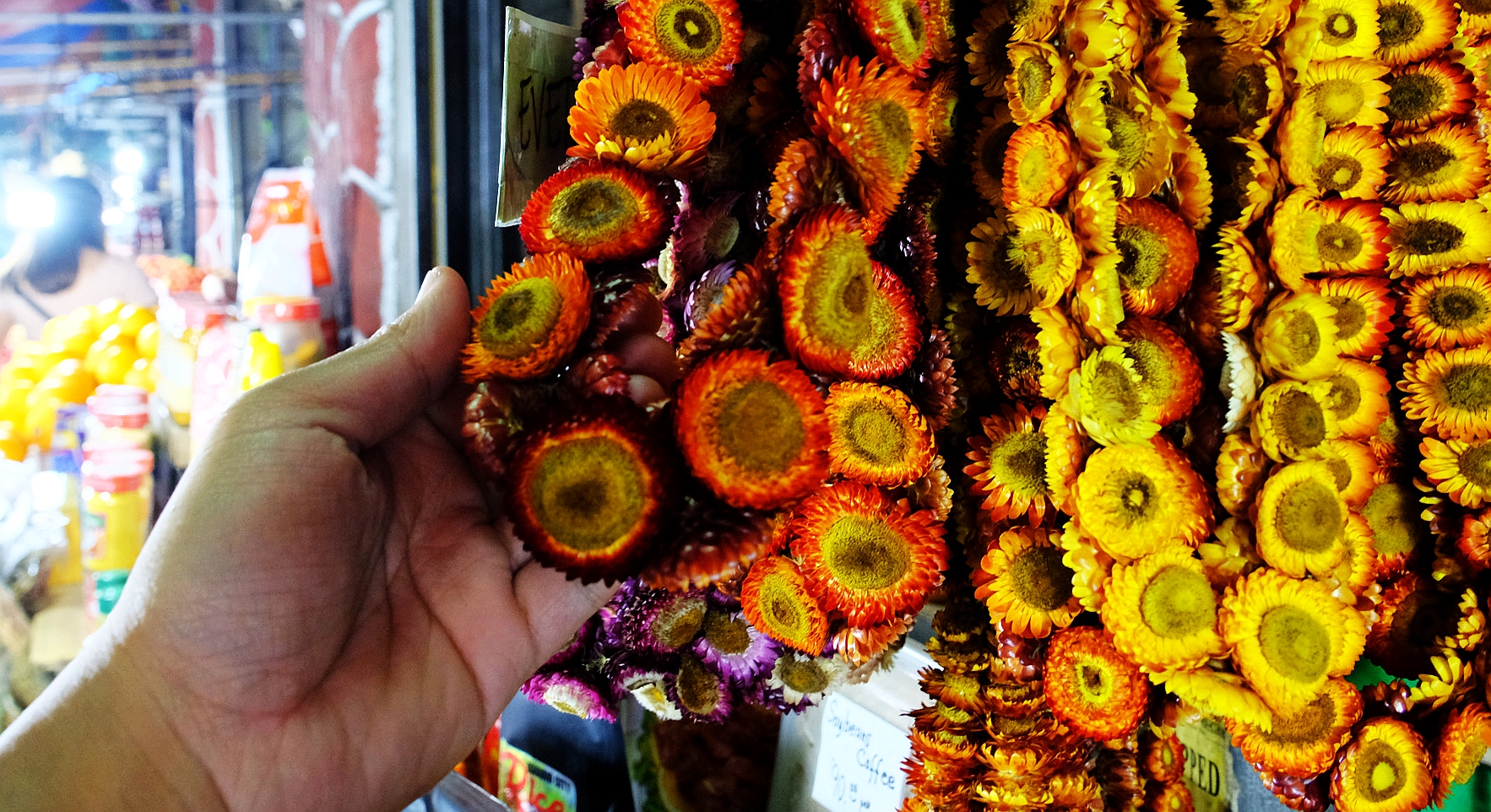
HISTORY VS UBIQUITY Baguio councilors are having a tough time choosing between the everlasting and the sunflower as the official city flower. The everlasting has been a longtime tourist souvenir since the 1960s, but currently the sunflower is more abundantly grown and sold. —photos by Neil Clark Ongchangco
BAGUIO CITY, Philippines — What should be the summer capital’s official flower?
Is it the increasingly rare everlasting, whose blooms are usually made into garlands as a handy souvenir from the city? Or is it the more common and eye-catching sunflower?
The spirited debate continued as members of the city council deliberated on Monday on a draft ordinance declaring everlasting (also called strawflowers, or Xerochrysum bracteatum) the flower that best represents the city, its popularity dating back to the 1960s.
READ: Baguio’s floral icons battle it out at Panagbenga
Introduced last year by Councilor Betty Lourdes Tabanda, the measure champions everlasting for its durability, which she said symbolized Baguio’s resilience.
The American-built city was reconstructed twice after it was flattened by American bombing toward the end of World War II and was again devastated by the 1990 Luzon earthquake.
“Everlasting communicates the identity of Baguio,” said the draft ordinance, which also called for the creation of a committee that would develop programs or activities celebrating the flower with an annual funding of P1 million.
But Councilor Peter Fianza, a former city administrator, said the City of Pines might not even need a new flower ordinance since it has already evolved into a “City of Flowers,” thanks to the popularity of the Baguio Flower Festival, also known as the Panagbenga.
The flower festival was launched in 1995 to revive Baguio tourism and boost rebuilding efforts after the 1990 quake, and its symbol has been the bright yellow sunflower (Tithonia diversifolia).
“Are we to choose a particular flower of the city? Wouldn’t it be better if we were known as the city of flowers rather than the everlasting city? ” asked Fianza during the regular council session on Monday.
Supply, demand
Small gardens in the towns of Atok and La Trinidad, both in neighboring Benguet, still grow everlasting flowers.
The Philippine Mine Safety and Environment Association also sponsored a section planted to everlasting at the Baguio Botanical Garden last year, but the move was seen more as a way to attract tourists, not really to commercialize the plant.
Cutflower farmers dry everlasting flowers and string them into garlands that are usually sold for P25 to P30 each, according to some Baguio flower vendors interviewed by the Inquirer.
But a garland can go for as much as P100 when supplies are tight.
A sunflower stalk, meanwhile, is sold for P50.
The flower festival was launched in 1995 to revive Baguio tourism and boost rebuilding efforts after the 1990 quake, and its symbol has been the bright yellow sunflower (Tithonia diversifolia).
Fianza also pointed out that the draft ordinance may no longer be necessary because a 33-year-old city resolution already identifies the everlasting as the official flower.
“This proposed ordinance should not be needed because, as early as 1991, there was a declaration by the city that everlasting is the official flora of the city through City Resolution (No.) 99 series of 1991,” he said.
But he recalled that the resolution was not passed unanimously because two of the 11 councilors at the time abstained while a third councilor voted against everlasting.
Resolution No. 99 was actually cited in Tabanda’s measure.
The 1991 document stated that everlasting “is very popular and synonymous with Baguio … [and it] grows best in full sun and thrives best in high altitudes like Baguio and Tagaytay.”
Fianza said deliberations on the resolution at the time also involved an everlasting-versus-sunflower debate.
He argued that the resolution based its selection of the everlasting on the flower’s “longevity” even though it “was not the most resilient flower.”
Medicinal
Fianza, an Ibaloy lawyer, added: “We have taken a look at the medical history of everlasting [and found] none, compared to the sunflower. Back in the day, when you were hurt or injured, you put on sunflower balm. It served as medicine at the time.”
The sunflower is also cited in the influential 1989 glossary “Common Medicinal Plants of the Cordillera Region,” written by the late acclaimed botanist Leonard Co.
According to a 2013 study titled “Antibacterial potential of some medicinal plants of the Cordillera Region,” published by the Indian Journal of Traditional Knowledge, the extract of Tithonia diversifolia “gave very active antibacterial activities against E. coli and B. subtilis [which are types of stomach bacteria].”
“People from the communities of the Cordilleras use herbal drugs not only as an alternative medicine but as the only source of medication for some who cannot afford to buy expensive pharmaceuticals,” according to the research.
The study was conducted by professors Teodora Balangcod, Rosemary Gutierrez, and Ronan Baculi of the University of the Philippines Baguio; Nardo Pastor of the Cordillera Career Development College; and Timothy Puma-at of the Mountain Province State Polytechnic College.
Tabanda joined Monday’s council session online but did not participate in the discussion. A decision to pass the draft ordinance on second reading was again deferred.
In earlier deliberations, a councilor had joked that it all boiled down to a choice between a flower that is “makati” (prickly and causing itchiness) and one that is “mabaho” (stinky).